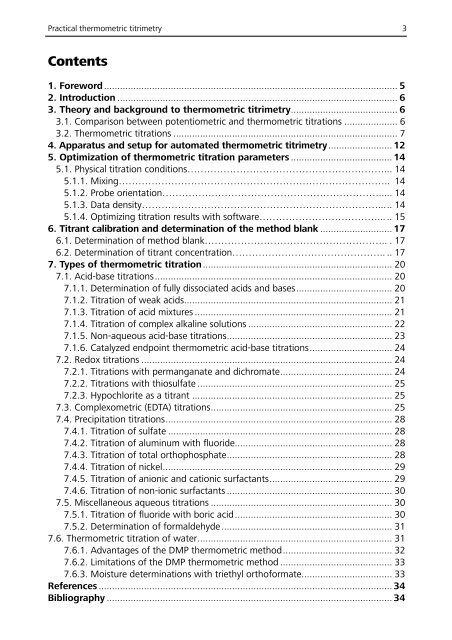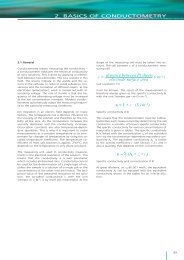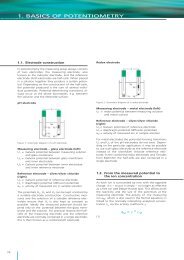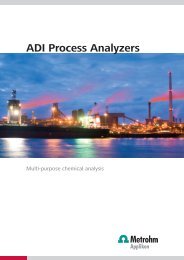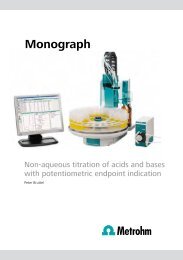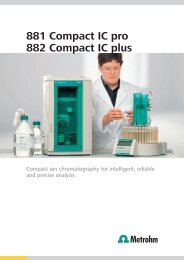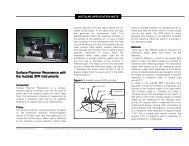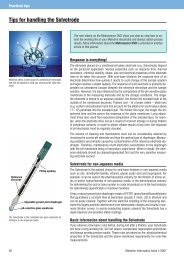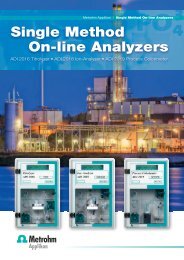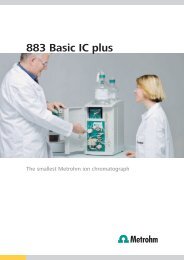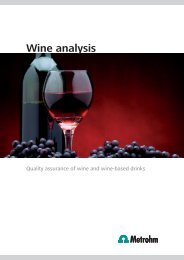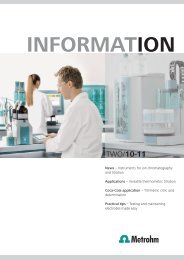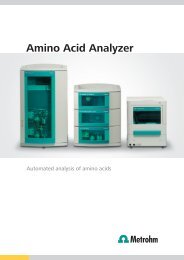Monograph - Metrohm
Monograph - Metrohm
Monograph - Metrohm
Create successful ePaper yourself
Turn your PDF publications into a flip-book with our unique Google optimized e-Paper software.
Practical thermometric titrimetry 3<br />
Contents<br />
1. Foreword............................................................................................................... 5<br />
2. Introduction.......................................................................................................... 6<br />
3. Theory and background to thermometric titrimetry........................................ 6<br />
3.1. Comparison between potentiometric and thermometric titrations..................... 6<br />
3.2. Thermometric titrations..................................................................................... 7<br />
4. Apparatus and setup for automated thermometric titrimetry........................ 12<br />
5. Optimization of thermometric titration parameters....................................... 14<br />
5.1. Physical titration conditions……………………………………………………... 14<br />
5.1.1. Mixing……………………………………………………………………….. 14<br />
5.1.2. Probe orientation…………………………………………………………..... 14<br />
5.1.3. Data density………………………………………………………………..... 14<br />
5.1.4. Optimizing titration results with software………………………………...... 15<br />
6. Titrant calibration and determination of the method blank............................ 17<br />
6.1. Determination of method blank……………………………………………….... 17<br />
6.2. Determination of titrant concentration………………………………………..... 17<br />
7. Types of thermometric titration....................................................................... 20<br />
7.1. Acid-base titrations......................................................................................... 20<br />
7.1.1. Determination of fully dissociated acids and bases.................................... 20<br />
7.1.2. Titration of weak acids.............................................................................. 21<br />
7.1.3. Titration of acid mixtures........................................................................... 21<br />
7.1.4. Titration of complex alkaline solutions....................................................... 22<br />
7.1.5. Non-aqueous acid-base titrations.............................................................. 23<br />
7.1.6. Catalyzed endpoint thermometric acid-base titrations............................... 24<br />
7.2. Redox titrations............................................................................................... 24<br />
7.2.1. Titrations with permanganate and dichromate.......................................... 24<br />
7.2.2. Titrations with thiosulfate.......................................................................... 25<br />
7.2.3. Hypochlorite as a titrant............................................................................ 25<br />
7.3. Complexometric (EDTA) titrations.................................................................... 25<br />
7.4. Precipitation titrations..................................................................................... 28<br />
7.4.1. Titration of sulfate..................................................................................... 28<br />
7.4.2. Titration of aluminum with fluoride........................................................... 28<br />
7.4.3. Titration of total orthophosphate.............................................................. 28<br />
7.4.4. Titration of nickel...................................................................................... 29<br />
7.4.5. Titration of anionic and cationic surfactants.............................................. 29<br />
7.4.6. Titration of non-ionic surfactants............................................................... 30<br />
7.5. Miscellaneous aqueous titrations..................................................................... 30<br />
7.5.1. Titration of fluoride with boric acid........................................................... 30<br />
7.5.2. Determination of formaldehyde................................................................. 31<br />
7.6. Thermometric titration of water......................................................................... 31<br />
7.6.1. Advantages of the DMP thermometric method......................................... 32<br />
7.6.2. Limitations of the DMP thermometric method........................................... 33<br />
7.6.3. Moisture determinations with triethyl orthoformate.................................. 33<br />
References............................................................................................................... 34<br />
Bibliography............................................................................................................ 34


